Competition number
In many sports, a competition number is used to identify and differentiate the competitors taking part in a competitive endeavour. For example, runners in a race may wear a prominent competition number so that they may be clearly identified from a distance. Competition numbers are differentiated from uniform numbers in that the former are used for a specific event (for example, competition numbers worn by marathon runners) while the latter persist over time through multiple events, seasons, or sometimes an entire career (for example, uniform numbers worn by Major League Baseball players).
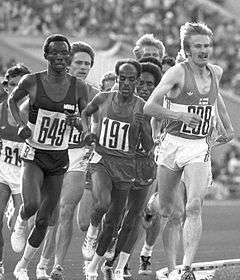
Competition numbers may also be called a bib number when worn on a bib over, or affixed to, the athlete's top.[1][2] With new technology, bibs might contain timing chips for electronic identification.[3][4] In addition to identifying an athlete, many high profile events also imprint sponsor logos. In such high profile events, bib numbers are mandatory. Failure to wear them could make an athlete subject to disqualification.[5]
Athletics
Since the 2000s, track and field athletes at major competitions wear their names as well as their numbers on their bibs. In relay events, all team members have the IOC country code. Track athletes also wear a lane number on the shorts called a hip number, for identification by the fully automatic timing system which photographs athletes from the side as they cross a finish line. In racewalking events, competitors also must wear a number on their back for identification by the judges after a violation has been detected.
In mixed competitions like marathons, where professional athletes run on the same course as non-elite athletes, the professionals traditionally wear a bib with their names to differentiate their pre-race status, but that does not guarantee success at the finish line.[6]
Gallery
 Robert Kipkoech Cheruiyot in the 2006 Boston Marathon with number on front of bib
Robert Kipkoech Cheruiyot in the 2006 Boston Marathon with number on front of bib 2009 World marathon runner with surname on front of bib
2009 World marathon runner with surname on front of bib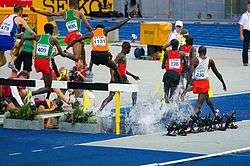 2009 World steeplechase runners with numbers on the back of bibs
2009 World steeplechase runners with numbers on the back of bibs- 2009 World 4 × 400 m relay team with "JAM" for the Jamaican team
Motorsport
In some types of motorsport, such as rallyes, competition numbers are attached to the vehicles taking part in a specific event. The competition number can also be used in conjunction with some kinds of timing systems, such as targa timing.
Gallery
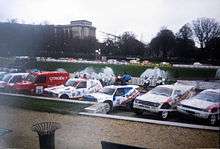 Cars of the 1992 Dakar Rally, with competition numbers such as 212, 214, and 215 visible
Cars of the 1992 Dakar Rally, with competition numbers such as 212, 214, and 215 visible A rally competitor displaying competition number C166
A rally competitor displaying competition number C166 A rally support truck, with competition number 624 visible
A rally support truck, with competition number 624 visible.jpeg) A motorcycle rally competitor, with competition number 6 visible
A motorcycle rally competitor, with competition number 6 visible
Other sports
Other sports that may utilize competition numbers / bib numbers include:
Gallery
 Alpine skiers
Alpine skiers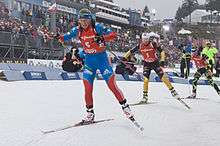 Biathaletes
Biathaletes_719.jpg) Gymnast
Gymnast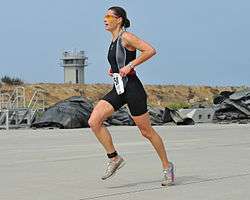 Triathlete
Triathlete
Notable competition numbers
While the uniform numbers of various sportspeople have become well-known (for example, Wayne Gretzky's 99, Michael Jordan's 23, and Mickey Mantle's 7), this is rare for competition numbers, which generally are used by an athlete only for a single event. Some notable exceptions include:
- 6 used by Paul Bikle, a gliding competitor. The Bikle T-6, a glider, was named for Bikle's competition number and the T-tailed design of the aircraft.[7]
- 13 in cycling, which is commonly worn upside-down due to triskaidekaphobia.[8][9]
- 51 in the Tour de France, due to a false belief that it has been worn by more winners than any other number.[10]
- 261 in the Boston Marathon, due to it being worn by Kathrine Switzer in the 1967 edition of the event, when she became the first woman to run the race as a numbered entrant.[11] Switzer later created a non-profit organization named 261 Fearless.[12]
At the 2019 Boston Marathon, organizers gave special bib numbers to several celebrities. Former NFL player Tedy Bruschi was given 5454, his uniform number repeated; NASCAR driver Jimmie Johnson was given 4848, his car number with Hendrick Motorsports repeated; and Joan Benoit Samuelson was given 1979, the year of her first win in the event.[13][14]
See also
References
- "What are Bib Numbers and Racing Bibs?". runningcount.com. Retrieved April 10, 2020.
- Rossen, Jake (August 15, 2016). "Why Do Some Olympic Athletes Wear Paper Numbers?". mentalfloss.com. Retrieved April 10, 2020.
- "BibTag System". mylaps.com. Retrieved April 10, 2020.
- "Innovative Timing Systems Chips". innovativetimingsystems.com. Retrieved April 10, 2020.
- "Rules: Event Entry & Registration Requirements". lamarathon.com. Los Angeles Marathon. Retrieved April 10, 2020.
- Huber, Martin Fritz (March 22, 2019). "How a "Non-Elite" Runner Won the NYC Half". outsideonline.com. Retrieved April 10, 2020.
- Said, Bob: 1983 Sailplane Directory, Soaring Magazine, page 37. Soaring Society of America November 1983. USPS 499-920
- "The 13 Kit". letape.nl. Retrieved April 11, 2020.
- Yost, Whit (November 17, 2016). "Do You Know These Cycling Rituals?". bicycling.com. Retrieved April 11, 2020.
- Lowe, Felix (June 30, 2016). "Tour de France: The legend of bib number 51". cyclist.co.uk. Retrieved April 10, 2020.
- Lorge Butler, Sarah (April 12, 2012). "How Kathrine Switzer paved the way". ESPN. Retrieved July 13, 2012.
- "261 Fearless". 261fearless.org. Retrieved April 10, 2020.
- Fisher, Jenna (April 15, 2019). "Boston Marathon 2019: Top Men And Women, Celebrities To Watch". Patch.com. Retrieved April 11, 2020.
- Golen, Jimmy (April 15, 2019). "NASCAR driver Johnson runs Boston Marathon in 3:09:07". apnews.com. Associated Press. Retrieved April 10, 2020.
Further reading
- Polloreno, Julia (October 5, 2017). "Can Your Bib Number Affect Your Performance?". triathlete.com. Retrieved April 11, 2020.
External links
- Thousands Of Runners Grab Bib Numbers, Gear At Boston Marathon Expo from CBS Boston via YouTube
- Triathlon Race Day Tips | Race Belt and Race Number via YouTube